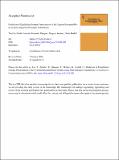Prediction of equilibrium isotopic fractionation of the gypsum/bassanite/water system using first-principles calculations
Abstract
The stable isotopes (18O/16O, 17O/16O and 2H/1H) of structurally-bound water (also called hydration water) in gypsum (CaSO4•2H2O) and bassanite (CaSO4•0.5H2O) can be used to reconstruct the isotopic composition of paleo-waters. Understanding the variability of the isotope fractionation factors between the solution and the solid (α17Omineral-water, α18Omineral-water and αDmineral-water) is crucial for applying this proxy to paleoclimatic research. Here we predict the theoretical equilibrium fractionation factors for triple oxygen and hydrogen isotopes in the gypsum-water and bassanite-water systems between 0 °C and 60 °C. We apply first-principles using density functional theory within the harmonic approximation. Our theoretical results for α18Ogypsum-water (1.00347±0.00037) are in agreement with previous experimental studies, whereas αDgypsum-water agrees only at temperatures above 25 °C. At lower temperatures, the experimental values of αDgypsum-water are consistently higher than theoretical values (e.g. 0.9749 and 0.9782, respectively, at 3 °C), which can be explained by kinetic effects that affect gypsum precipitation under laboratory conditions at low temperature. We predict that α18Obassanite-water is similar to α18Ogypsum-water in the temperature range of 0 °C to 60 °C. Both α18Ogypsum-water and α18Obassanite-water show a small temperature dependence of ∼0.0000122 per °C, which is negligible for most paleoclimate studies. The theoretical relationship between α17Ogypsum-water and α18Ogypsum-water (θ =lnα17Olnα18O) from 0 °C to 60 °C is 0.5274±0.00063. The relationship is very insensitive to temperature (0.00002 per °C). The fact that δ18O values of gypsum hydration water are greater than free water (α18Ogypsum-water >1) whereas δD values of gypsum hydration water are less than free water (αDgypsum-water <1) is explained by phonon theory. We conclude that calculations from first-principles using density functional theory within the harmonic approximation can accurately predict fractionation factors between structurally-bound water of minerals and free water.
Citation
Liu , T , Artacho , E , Gázquez , F , Walters , G & Hodell , D 2019 , ' Prediction of equilibrium isotopic fractionation of the gypsum/bassanite/water system using first-principles calculations ' , Geochimica et Cosmochimica Acta , vol. 244 , pp. 1-11 . https://doi.org/10.1016/j.gca.2018.08.045
Publication
Geochimica et Cosmochimica Acta
Status
Peer reviewed
ISSN
0016-7037Type
Journal article
Description
This research was supported by the ERC WIHM Project [#339694] to DAH.Collections
Items in the St Andrews Research Repository are protected by copyright, with all rights reserved, unless otherwise indicated.

